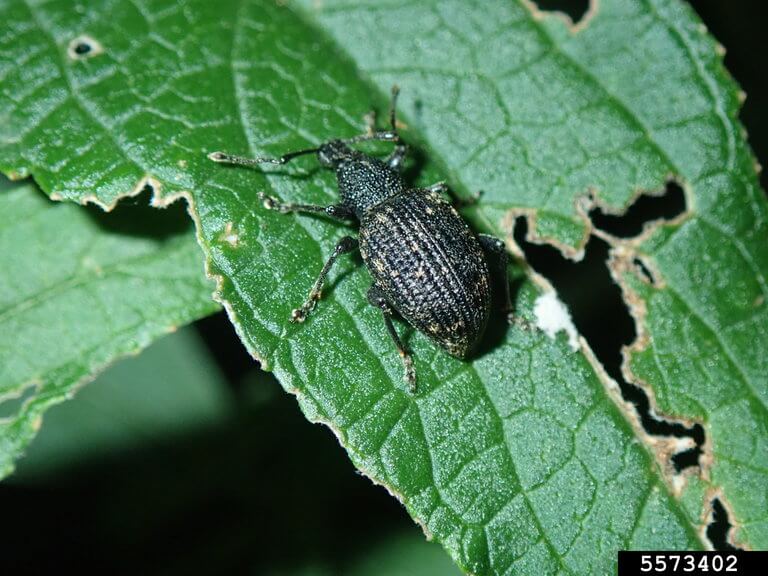
Because they feed at night, you are more likely to see root weevil damage than the weevils themselves. Whitney Cranshaw, Colorado State University, Bugwood.org.
Root weevils can be a troublesome pest of rhododendrons and other evergreen shrubs. It may seem like the damage to plant leaves appears out of nowhere. Because the adult root weevils feed at night, we see the damage but no insects. Notched leaves, especially along the edges, are a sign that root weevils are at work.
Root weevil larvae larvae feed on roots and stems. They may completely girdle (remove a ring of bark) the stem and kill the plant.
These insects primarily chew on broadleaf evergreen shrubs. In particular, they seem to love rhododendrons, azaleas, pieris, viburnums and laurels. Because these plants take a while to lose their leaves, the notching will stay visible for many years.
Mild to severe notching of new leaves is mainly an aesthetic nuisance and will usually not damage the plant’s overall health. But it can be a sign that the plants are under stress. Plants that are stressed are more vulnerable to insect damage.
Preventing root weevil damage
Choose plants that are resistant to root weevils.
Whether buying new plants or replacing plants that have been damaged by root weevils, choose something that root weevils don’t like. There are many varieties of rhododendrons and other susceptible shrubs that are naturally resistant to root weevils. Plants vary in resistance, but some can be 100% resistant.
Leaf shape appears to affect a rhododendron’s resistance. Leaves that have a slight roll on the edges tend to be avoided by weevils because the roll creates an edge too wide for the root weevil’s mouth. WSU research also found that rhododendrons with dark red flowers are likely to be susceptible to root weevil damage.
These publications from Thurston County and the City of Seattle and Thurston County include lists rhododendrons that are resistant to root weevils. You could also ask a Master Gardener or your local nursery for recommendations.
Take good care of your plants.
- Make sure you are using the right amount of water. Young rhododendrons need frequent watering for the first few years. As they mature, they still need regular watering to stay healthy.
- Use organic mulch, such as compost or arborist chips, to feed the soil and help keep your shrubs healthy.
- Proper fertilization is also important. Fertilize in early spring with a complete fertilizer. Use a light hand with rhododendrons and azaleas. They need less fertilizer than other shrubs, and too much fertilizer can harm them.
- Prune up branches that touch the ground to reduce access. Root weevils need to travel along branches to get to the leaves.
Limiting root weevil damage
Contact us for our natural tree and shrub care service.
We use beneficial nematodes in our ongoing tree and shrub care service. These are microscopic organisms that attack the root weevil larvae as they grow in the soil below the shrubs. This reduces populations before they become adults. Nematodes are nontoxic to plants and other animals.
The technicians look for recent root weevil damage to the leaves and apply nematodes if they see damage. Soil temperatures and moisture are right for the service at this time of year. If it’s dry and hot out, the nematodes won’t survive in the soil very long.
You can read more about beneficial nematodes in this article by OSU Extension.
Apply sticky or slippery barriers.
Barriers are applied around the trunks or stems near the ground. These products discourage or trap the adults as they travel up trying to reach leaves. Barriers work best when the shrubs are not touching other plants.
You can wrap the trunk with plastic or tape and apply a sticky product onto the tape. Or you can use slipper teflon barrier tape. Make sure the barrier is tight enough that the insects cannot make a path under it. It must be removed before it restricts stem growth.
You will need to replace or replenish sticky barriers frequently. Otherwise, organic material like leaves, dirt or dead insets will collect on the substance and form a bridge over the treated area.
We do not recommend chemical controls.
Some of these chemicals will kill beneficial insects such as predacious ground beetles and bees.
Resources
Common Sense Gardening: Root Weevils, Thurston County. How to use nontoxic control methods, along with a list of resistant hybrid rhododendrons.
Root Weevils: Troublesome Rhododendron Pests, American Rhododendron Society. Information about physical, chemical and biological control methods.
